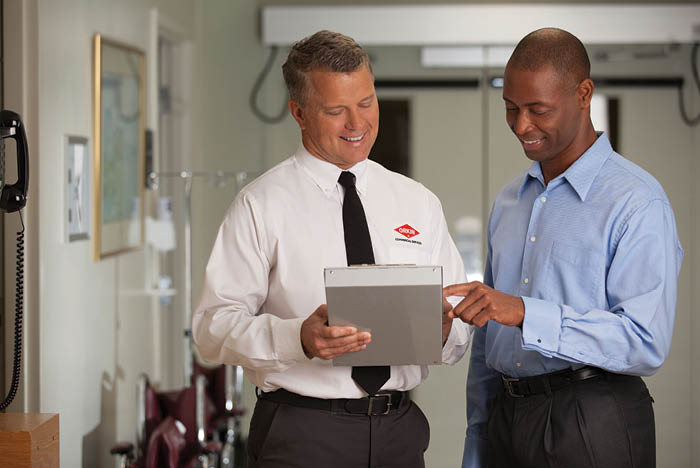
A pest control provider can help lead a comprehensive facility audit.
Image courtesy of Rollins Inc.
The pandemic has kept the spotlight on hospitals and other health care facilities over the past two years as caseloads surged and medical staff were stretched thin. The last thing environmental services (EVS) managers need in this stressful environment is a pest problem.
Rodent and insect intruders not only carry real disease threats for patients and staff, but they also represent a reputational risk that could hurt a hospital’s quality scores. Unfortunately, health care facilities are especially susceptible to pest problems, especially in this environment of high traffic and low employee headcount.
So, if a hospital hasn’t already adopted integrated pest management (IPM), now is the time.
Three key elements
IPM helps prevent pests from entering a health care facility and from damaging supplies and property if they do slip in. It’s easy with an established program that addresses the following three key elements:
- Sanitation. Moisture and food debris attract pests, so it’s critical that hospital staff members wipe down equipment and clean up spills and leaks as soon as possible. Drains need regular inspections for buildup, and products and supplies should be stored off the ground on open shelving to avoid pests nesting and going undetected.
- Exclusion. Regular exclusion measures keep pests outside. The exterior of the property should be inspected regularly so that cracks and crevices can be sealed before they become a welcome mat for pests. EVS managers also should look for broken vent covers, damaged weather stripping and missing door sweeps that could leave the hospital vulnerable.
- Ongoing inspections. It almost goes without saying that health care facilities require regular pest control inspections.
Types of facilities
Hospitals are particularly vulnerable to bed bugs, flies and rodents. The ongoing movement of beds, bedding and clothing as patients are transferred through the facility helps bed bugs to spread quickly. Flies are attracted to organic waste, especially from hospital restaurants and food service areas. EVS managers should make sure staff is regularly disposing trash and sanitizing dumpsters and compactors.
Rats and mice carry many diseases they can deposit through their urine, droppings and through parasites that attach to their fur. Keeping them out requires keeping loading docks closed and staying extra vigilant about telltale signs. Mice can fit into holes the size of a dime, so EVS teams should scout for these entry points and see that they are properly sealed.
If a hospital facility is under construction, EVS managers should be sure there is no passageway that rodents could follow to the inside. A special note for emergency departments and urgent care centers: These locations host high volumes of people, and some of those individuals may carry head or body lice without knowing it. EVS managers should be sure to give exam rooms and waiting rooms extra attention.
Managers in nursing homes and assisted living facilities face some of these same threats but also should watch out for grain beetles and pantry moths, which appear when residents store boxed food for too long in their kitchenettes.
Outpatient centers tend to generate a lot of organic waste, which attracts ants, cockroaches and flies. Ants are among the most difficult insects to control. Their colonies can grow into massive populations if left untreated, so it’s important that EVS managers deal with an ant problem as soon as it shows up.
If a hospital operates a rehabilitation center, there are more points of entry to keep an eye on. The constant influx of people and their personal belongings leaves these areas open to bed bugs and other pest problems.
Finally, EVS professionals in charge of physician or dental offices should be aware of the typical hot spots: common areas, waiting rooms, restrooms, breakrooms and places where supplies are stored or waste is disposed. They should be mindful that staff and visitors in waiting rooms often bring in food, which can attract a variety of pests looking for their next meal.
Four IPM steps
IPM is an important practice to prevent infestations and provide a game plan for managing them if they occur. To cover all the bases and set up a comprehensive IPM plan, EVS managers should follow four key steps for prevention:
Step 1. Assess the risks inside and outside the facility. A pest control provider can help lead a comprehensive facility audit, showing areas of vulnerability and advising on ways to fix potential problems. During this tour, the provider can point out signs of pest activity and can help pinpoint specific pests that may already be a threat.
Step 2. Create a pest prevention plan. Following the inspection, a provider should develop a detailed playbook with techniques to prevent pest intrusion. This plan should include tips on sanitation products and practices, hot spots to put on the watch list, instructions on proper storage of food and supplies, and building and facility maintenance steps that should be taken to shut down entry and harborage areas for pests in the area. This plan should be customized to a specific facility and its age, location and business type.
Step 3. Plan implementation. Once the plan is set, the pest control provider should layer in the specifics to ensure the EVS manager and team stay vigilant. These specifics should include staff training so the entire team can be facility scouts, and a schedule of regular service dates when the pest control provider will return on property to assess any changes. The goal always should be to keep the facility audit-ready so there are no surprises during compliance inspections.
Step 4. Regular monitoring and documentation. A key part of IPM is ongoing monitoring to ensure that the established program is working. EVS managers should make sure that their pest control provider documents the services performed at each visit and logs any pest problems spotted, providing prescriptive actions for any issues that were discovered. Frequency of service depends on a variety of factors unique to each operation, such as the age of the facility, the efficacy of the sanitation program, and the setting and climate at the location.
Following the four S’s
Given the sensitive nature of hospitals and other health care facilities, a noninvasive approach to pest control is essential. An easy way for EVS managers to remember where to focus is to stress the following four “S” words:
- “Settings” identify where pest problems tend to start. Hospitals face many challenges when it comes to sanitation, starting with high traffic and constant patient turnover. Each unique environment comes with its own set of challenges.
Typically, there are multiple exterior doors, large loading docks and lots of different people — patients, medical personnel, staff and visitors — moving about constantly. With so much foot traffic from the outside, pests can “hitchhike” their way into facilities on clothing, supplies, shipments and equipment. Once they get inside, they often find the three big things that help them survive: food sources, water sources and moderate temperatures.
- “Symptoms” that can be spotted help EVS managers know which pests are a problem. Bed bugs often leave behind fecal smears that resemble ink-colored stains on mattresses, bedding or other soft furnishings. They also cast off their skins as they grow, leaving behind tiny shells. If spider webs are present in corners or windowsills, that’s a clue that other insects are nearby. Rodents leave droppings in drawers, cupboards and other hidden areas, and these droppings vary in shape and length, depending on the species.
If there is a cockroach infestation, oval-shaped egg cases may be evident in spaces behind furniture or equipment. Flies start as maggots in their larval stage, and they are attracted to food refuse and garbage storage areas. A few ants mean there could be a colony. Look along the building’s exterior to find the source of the problem. Building exteriors also are the place to look for bee, hornet or wasp nests in shaded areas.
- “Shut-out” is another way to remember the concept of exclusion. The single most important way to keep pests out is to stop them in their tracks by eliminating their access from the outside. Entry points as small as one-sixteenth of an inch can provide access. EVS managers should regularly focus on doorways, loading docks, dining and food areas, common areas, storage rooms and the building’s exterior.
EVS teams should never leave doors or loading docks open for extended periods of time. And remember that moisture attracts insects. That’s why restrooms and food prep areas should be cleaned and sanitized often.
- The best “solution” for a pest-free facility is for EVS managers to proactively adopt an IPM approach. In the long run, this proactive rather than reactive approach is more cost-effective than waiting to treat a problem once it arises. The Environmental Protection Agency also believes it’s a safer approach because it often reduces the need for pesticide applications.
Teamwork is essential
EVS managers have a lot of ground to cover to keep hospitals constantly clean and in compliance. That’s why it’s very important to involve the entire EVS team through an all-hands-on-deck approach.
Pest control providers should be able to help EVS managers with baseline training and supply tools to use as new employees join the team. All EVS employees should know what causes pest issues. They should adopt and follow best practices and know which products to use for optimum safety and sanitation.
Their training should cover where to look and what to look for during their shift. And, if an EVS employee spots a potential pest issue, they should know to report it promptly so the pest control provider can address it as soon as possible.
It’s often helpful to assign each team member a specific watch area so that all points on the property are regularly monitored. Sometimes, creating a reward program can motivate housekeeping staff to adopt a “pest patrol” mentality that results in great outcomes for morale as well as overall pest management.
Pest control management is a lot like health care management. Adopting best practices and committing to a routine of regular checkups keeps small issues from escalating into bigger ones. Health care EVS managers are responsible for the health and maintenance of complicated, multifaceted spaces.
Adopting an IPM approach, which includes routine inspections, documentation and quality metrics, allows health care organizations to keep patients, and not pests, as their top priority.
Glen Ramsey is a senior technical services manager for Rollins Inc., Atlanta. He can be contacted at gramsey1@rollins.com.



